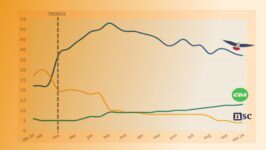In the Netherlands, too, we are now seeing a sudden return of the flu. This is mainly explained by the ending of the measures. But that cannot be the main reason if you look at the patterns in the rest of the world. However, that wrongheadedness can lead to measures again. History then threatens to repeat itself.
Lees volledig artikel: The magical return of the flu and the reason behind it
The magical return of the flu and the reason behind it
The flu patterns
One very remarkable phenomenon of the Covid-19 outbreak was that worldwide the flu disappeared almost immediately. And that it did not return anywhere in the world during the normal flu season of 2020-2021.
But now we see in the Netherlands -and in several other countries- that the flu has returned -to a strong degree. And this at the end of the normal flu season (which usually runs somewhere from week 44/48 to week 8/14). On this informative site you can make the overviews for almost all countries in the world.
Various explanations are given for that particular pattern of flu. And I’m rather worried that, as with Covid-19, people may have the wrong explanation for it, which may lead in the next high season of flu to similar government measures (such as lockdowns) as we had with Corona. Because the WHO and the CDCs around the world attribute this pattern primarily to the effects of the measures taken and withdrawing them again! And in doing so, they risk making the same mistake they did in 2020!
First, a quick picture of a few countries. This is the Netherlands. The height of the graph does not necessarily imply the severity of the flu. There were significantly more victims in 2017-2018 than in the two years before and after. However, it is an indication of the extent of spread:
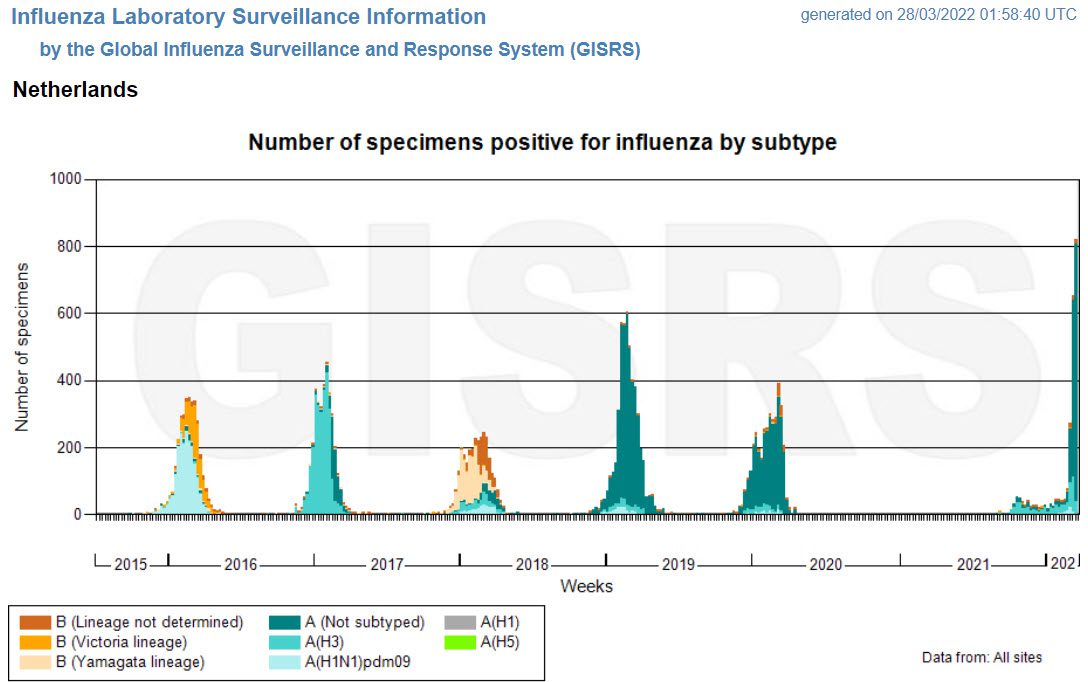
This graph shows very well the seasonal pattern in the Netherlands (from weeks 44/48 until sometime in March-April). It also clearly shows how in March 2020 the flu abruptly disappeared, how it wasn’t there in 2020-2021, and how in 2021-2022 it didn’t really reappear until sometime in late February.
In many other countries that are above 30 degrees North latitude or below 30 degrees South latitude, we see this seasonal effect in the winter of that country.
This is Denmark:
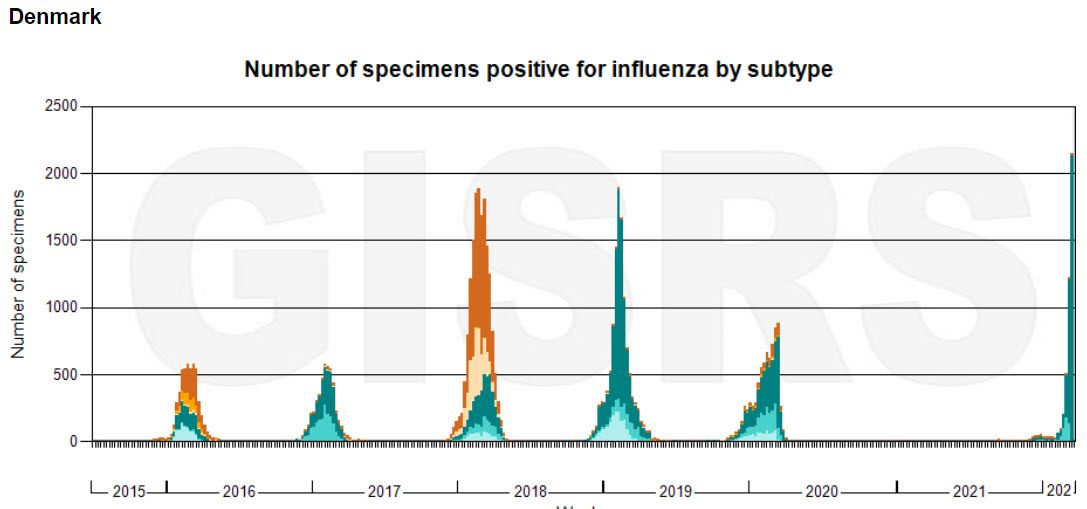
And in Chile, which is in the Southern Hemisphere, it’s easy to see that the flu there appears mostly in the winter months, but not in their winter of 2020 and of 2021 as well. Only an a-typical uptick after the turn of the year 2021/2022.
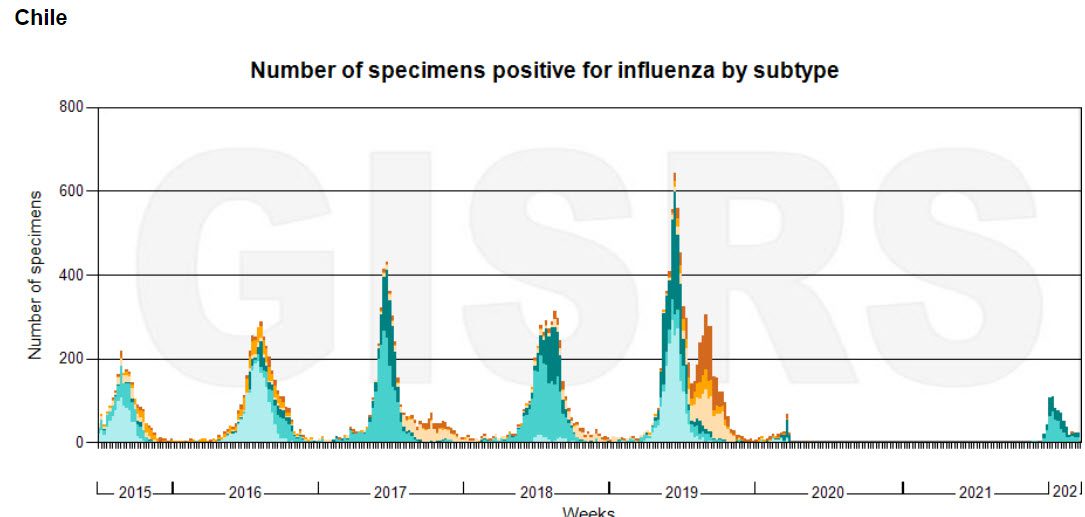
In subtropical and tropical areas, the pattern is much more erratic. For example, look at these four countries: Thailand, Columbia, Costa Rica and Senegal.
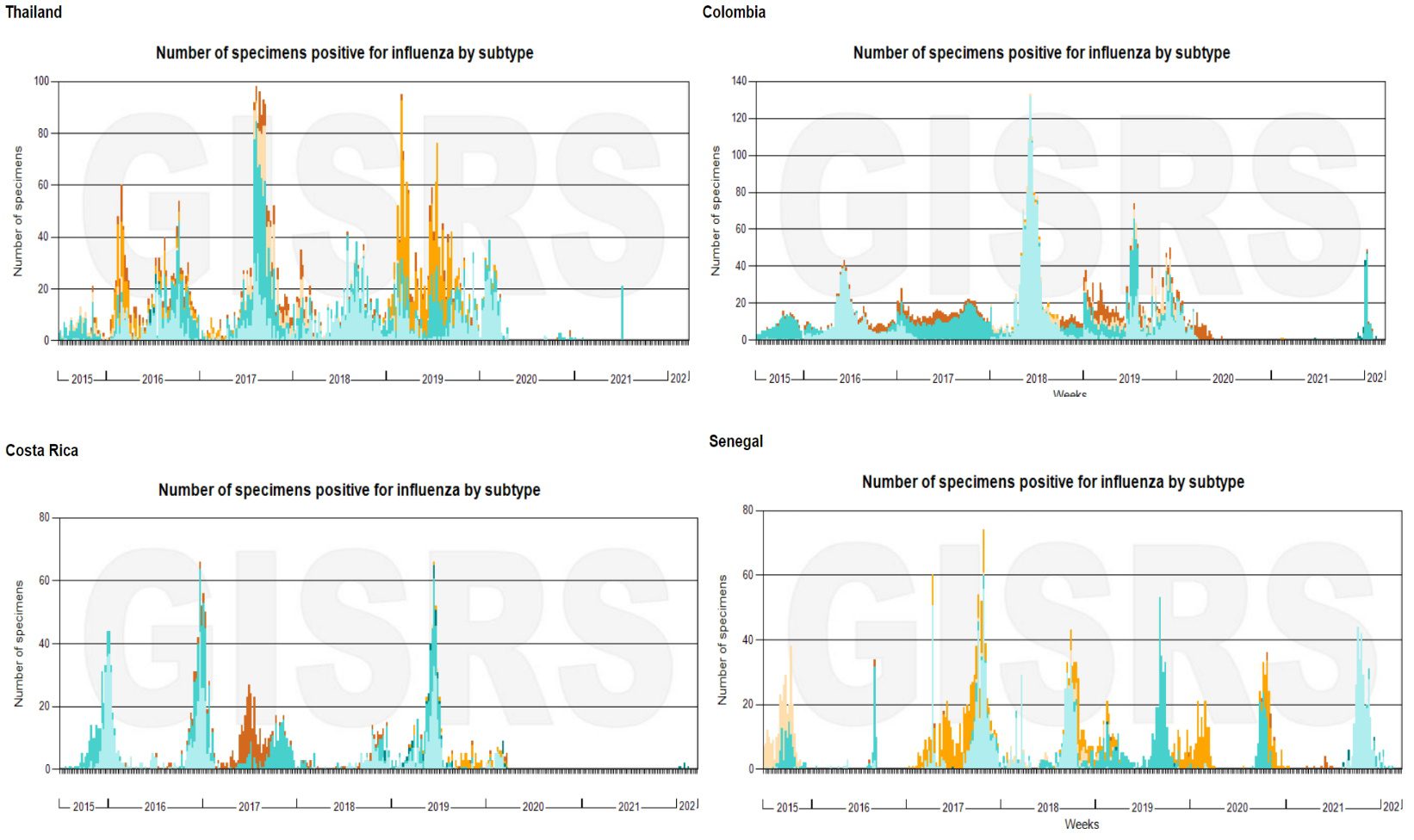
In China, flu waves are above 30 degrees North lattitude in winter and below it in summer! (Wuhan is above that 30 degrees N latitude and so it broke out there in the winter of 2019-2020).
The possible explanation
On our site, we have been writing since May 2020 about the relationship of the patterns of Covid-19 spread and past influenza. But also about the absence of the flu from March 2020 and what might be the reason for that. In a May 2020 article, we described a large WHO congress from 2014, where they described those different patterns worldwide of influenza and had no real explanation for the difference in pattern between countries in our region and in the sub-tropical areas. With an important quote from a major study on those influenza patterns from 2007
There are many unexplained patterns in studying the spread of infection. But none have been studied in as much depth and as little understood as the seasonal patterns of influenza.
We have also posted several articles since then on the relationship between Covid-19 spread and the disappareance of the flu. Also this article by Canadian author Julius Ruechel from early 2022 provides much relevant information.
Roughly speaking, there are two explanations for the fact that influenza has disappeared for a while and is now coming back in many places:
- It is mainly due to the success of the measures. The flu disappeared as a result, and now that the measures have been withdrawn, the flu is back. This is the point of view of the Dutch CDC.
- It is a well-known pattern in viruses, described by Hope-Simpson in his famous 1992 book on the spread of influenza as the vanishing trick of viruses. A good example of this was the swine flu that abruptly disappeared from the Netherlands in December 2009. (But one does not really know what caused this.)
It will be clear that if one assumes the first explanation and there is a new major flu wave with a high burden on health care, it is very tempting to take various measures that were used against Covid-19 out of the “toolbox”. But just as with the spread of Covid, which would go through “big droplets”, I also dare to doubt the statement of the dutch CDC about the disappearance and reappearance of influenza. Measures have played and still play only a small role.
Look at these countries
If you look at Japan, South Korea, Australia and New Zealand right now, there is still no influenza there as of March 2020. However, there is a big difference between the first two and the last two countries. In Australia and New Zealand, the normal flu season will only start soon (at the end of autumn sometime in May). In Japan and South Korea, they still/only have a major Covid-19 outbreak.
And in India (and Nepal) on the other hand, there was another flu season in certain parts in the second half of 2021. In India, it normally takes place during the monsoon (which is distributed across the country from May to November). So why did the flu reappear in India in the second half of 2021 and not in East Asia?
Is it because of the measures in those different countries? Again, it’s tempting to argue that. But I still dare to doubt that. Take for example a look at Great Britain and Sweden.
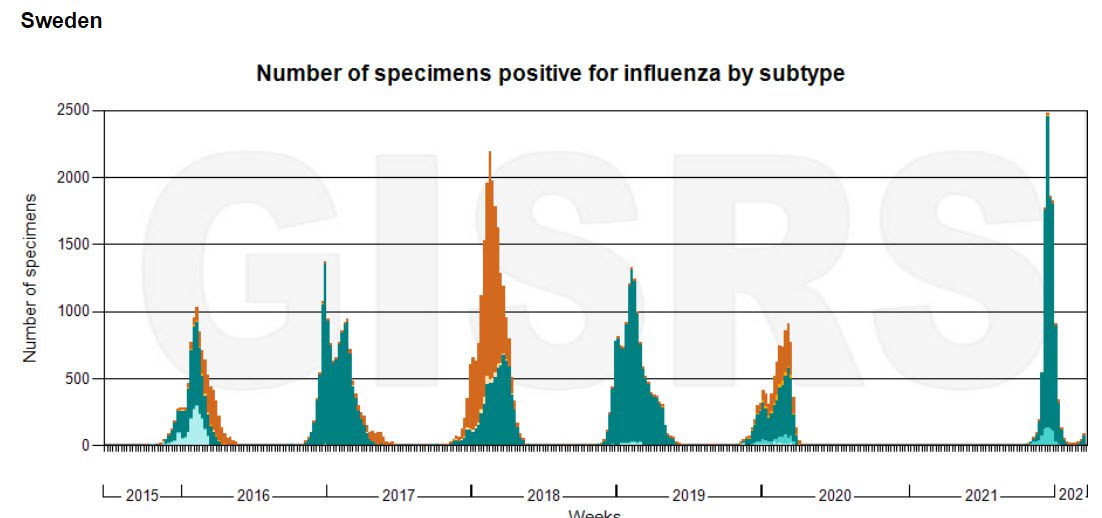
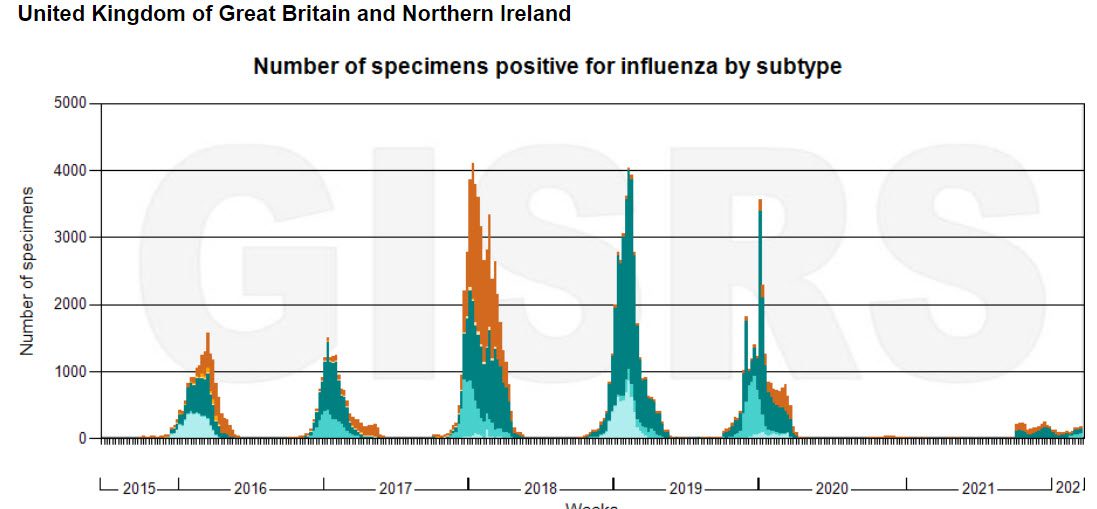
England
In England, the measures were withdrawn by mid-July 2021. Despite this, there has been no real flu season 2021-2022 there. And even now there is less flu than in the Netherlands.
In Sweden, measures have generally been much more moderate. There, between March 2020 and autumn 2021, they had the same pattern in flu as we had, but around week 44 of 2021, flu broke out there and it didn’t in our country. That flu period stopped quite abruptly in week 3, only to now show an increase again. So how is that possible? Because of new measures in Sweden? No, that has not been the case.
And if we look at the evolution of influenza in the US states on this insightful site it is easy to see that between week 49 of 2021 and week 2 of 2022 influenza was observed in many US states, but virtually disappeared again in week 5 of 2022 and is now returning in some states.
These observed patterns cannot be attributed to the effect of – withdrawing – measures. They point to that other explanation. The vanishing trick of a virus as Hope-Simpson called it.
The possible explanation of the pattern
Because in many places Covid-19 was at a low ebb and many people had already built up immunity, the pattern from Sweden and from the states in the U.S. indicates that influenza in those locations had room to run during the “normal” influenza season. But where Covid-19 still prevailed or received a new boost via Omikron, there was no room for the flu virus or it was pushed out again (as can be clearly seen in Sweden and the US from mid-January onwards).
Where the population has already built up a high degree of immunity to the Omikron variant, as is now the case in the Netherlands and Denmark, there is apparently room for the flu virus to spread again.
Now, it is certainly the case that if -for whatever reason- people meet significantly less during the normal flu season, the rate of spread of the virus slows down. And virtually stopping travel between countries can also certainly reduce the rate at which flu spreads around the world (think especially of countries, which can organize isolation, such as New Zealand). But whether or not the flu is present to a large extent is primarily related to whether or not we have substantial numbers of new infections of Covid-19.
And so if you do think that the stagnation of the flu was mainly due to the measures, then it is very tempting to take these measures out of the toolbox again when things get too busy in healthcare.
But what makes it happen?
In March 2020, based on data analysis of the spread patterns of Covid-19 and studies of the mode of spread of influenza by physicists (such as Marr, Allen, Prather and Jimenez), I concluded that Covid-19 mainly spread -or perhaps almost exclusively- through the air. And thus not particularly through large droplets, as WHO indicated.
If you assumed the airborne spread, then that made much more sense with respect to the patterns you saw than if you assumed the spread through large droplets. Certainly now that the current Omikron variant is spreading as easily as measles, there should be little discussion of airborne spread as by far the most important mode of spread (just as this has been assumed for measles since 1985).
This also explains the seasonal patterns of influenza and the difference between the patterns at home and in the (sub-)tropical regions. (You can read more about this in these two articles from our site in 2020 (1) and (2)).
Although it is no more than a hypothesis, I also have a logical explanation for why apparently one virus displaces another – abruptly. It may be as controversial as the aerosols story was in March/April 2020, but it would provide a good explanation for the patterns observed. And if the hypothesis is true, it could tell us a lot about the sense or nonsense of applying the components of the toolbox.
This hypothesis has three main components:
- If there are few people with immunity to a particular respiratory virus, that virus will spread easily and rapidly. If there are many people with immunity to that virus, that virus will not be able to cause large outbreaks.
- There are conditions of season and climate, which in a given location create much more favorable and unfavorable situations for airborne spread of a respiratory virus. The normal patterns of influenza in specific geographical locations are a strong indication of this.
So far you are not reading anything new or special. But that is not the case with the next argument:
My hypothesis is that there are many more virus particles (virions) in the air, which can lead to infection of the respiratory organs, than we assume.
Not in high concentrations, but usually in (very) low concentrations. It is only when you breathe in a high concentration for a long time that you become infected and your body tries to expel the invader. Depending on a combination of factors, which determine the strength of your immune system and the experience your body has had with the virus before, determine the success of your line of defense. Only when you have exceeded your personal limit of virus particles to be inhaled there is an infection with all the trimmings. So the viral doses are the determining factor, like we have known already for a long rime.
I’ve described before that breathing in low concentrations for a while can also provide better protection when you’re exposed to a higher concentration. (Prof. Bouma called this “micro-vaccinations”).
By assuming these larger numbers of virus particles in the air, it is easier to understand what happens in “competition” between two different viruses, such as Covid-19 and influenza.
For:
– As more people are not yet immune and more virus particles are in the air, many more people will cross that limit of viral doses and become infected and they will then also produce more virus particles back into the air themselves. This then gives the picture of rapid exponential growth. With many particles in the air, but also a rapid decline again as the arsenal of people who can still be infected decreases rapidly (Gompertz curve).
– If the above happens, another respiratory virus, to which quite a few people are already immune, gets less opportunity to infect those people. So, on the one hand, that happens because there are fewer people who can get infected and then bring new virus particles into the air. But on the other hand – and this is the crucial point with this hypothesis – only one virus at a time can cross the threshold of infection.
The reasoning above would be a logical explanation for why one virus can quickly displace another. Moreover, it also provides an explanation for the observed seasonal patterns of flu in different regions:
– In warmer and more humid weather in the areas above 30 degrees N lattitude and below 30 degrees S, the virus remains airborne for much less time and thus people inhale the virus much less, except in special situations.
– And in (sub-)tropical areas, in very humid weather, particularly during rain and thunderstorms, larger water droplets remain in the air for longer periods and people then sit close to one another for a while, allowing the virus to enter the lungs in this way. In addition, air conditioning can also be responsible for creating an unfavorable situation through artificially lower temperatures and lower humidity.
So if this hypothesis is used as a possible explanation for the flu developments that are now taking place worldwide, then two factors are of great importance:
- Is it the flu season, with therefore favorable conditions for the virus to remain in the air for a long time?
- To what extent does Covid-19 still prevail (now with the Omikron variant). If many have already become immune, then there is room for influenza to re-emerge.
So what is important is whether the influenza virus entered the country. (So New Zealand’s high degree of isolation may have prevented that so far. But then when the normal flu season starts there again in May, the flu should start to reappear there as well or Omikron).
Plus it could be that because flu has been gone for almost two years in many countries, the number of people who can get flu is higher than normal and partly because of that the season could stretch over a somewhat longer period than normal. So perhaps the flu could then be present in the Netherlands even in May.
After reading the above, you probably realize how important it is not to simply assume that the absence of the flu was mainly due to the measures taken. Because that would, in the event of a major outbreak in the next flu season, pave the way for certain measures of the Covid-19 period.
You have just read: The magical return of the flu and the reason behind it.









